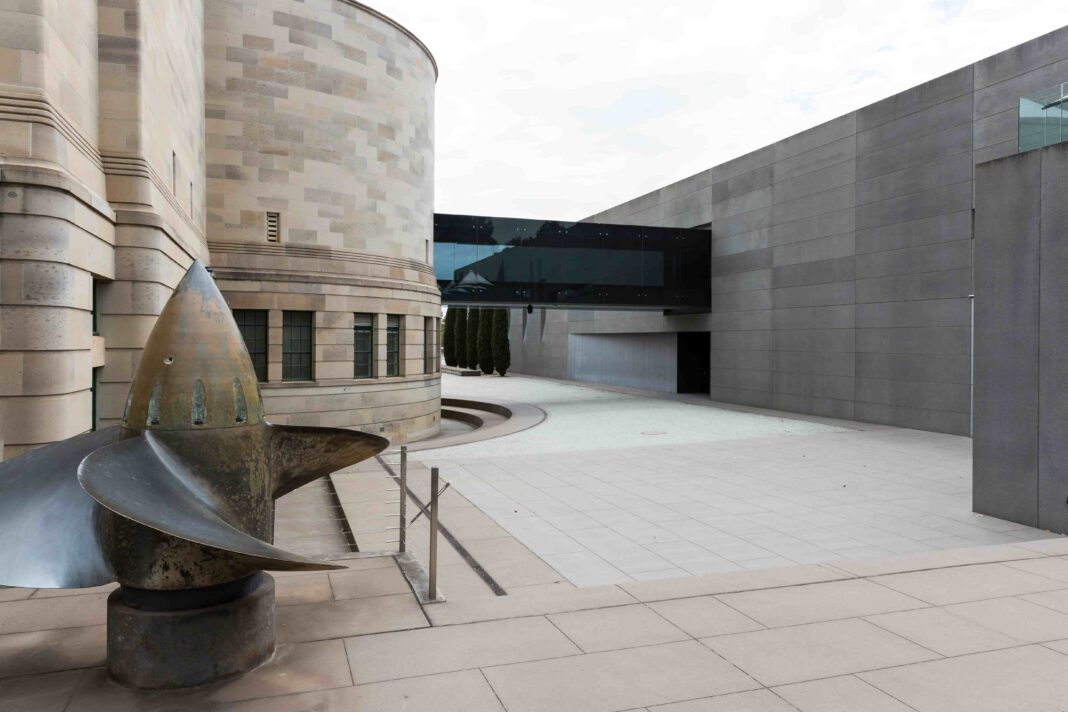Goodbye, Piccadilly; farewell, Anzac Hall. A controversial proposal to demolish the Australian War Memorial’s award-winning exhibition space, in order to build a gallery almost twice the size, has been passed.
Environment Minister the Hon. Susan Ley MP approved the $500 million redevelopment proposal on Thursday (11 December) under the Environment Protection and Biodiversity Conservation Act 1999 (EPBC Act).
AWM director Matt Anderson welcomed the approval. “This is the first of three major approval processes required to progress the development, which aims to honour the commitment of the 100,000 Australians who have served our country over the past 30 years,” he said.
Anzac Hall was built as a modern, flexible exhibition hall of 3,000 square metres to house the Memorial’s large technology items, such as planes and boats. It was designed by Denton Corker Marshall in 1999 and completed in 2001 at a cost of almost $11.3 million; in 2005, it received the Australian Institute of Architects’ Sir Zelman Cowen Award for public buildings for its design excellence.
But Anzac Hall was no longer fit for purpose, Mr Anderson recently told ABC Radio National; there was insufficient space to tell the stories of Australians who have served overseas since 2001 in trouble spots like Afghanistan or Iraq.
The new exhibition space is intended to be 80% larger, with dedicated Middle Eastern galleries – rather than “a beret and a photo” in a space Mr Anderson said he can walk across in 15 paces.
Former directors, war veterans, and the Australian Heritage Council have opposed the plan since former director Brendan Nelson mooted it in 2018.
The Australian Institute of Architects claim Ms Ley’s decision will undermine confidence in Australia’s heritage protection framework and the operation of the EPBC Act.
“This is a disgraceful decision that sets a dangerous precedent for the future of our nation’s heritage,” Clare Cousins, #handsoffAnzacHall campaign spokesperson and the Institute’s former president, said.
“It comes towards the end of a deeply flawed process notable for its lack of transparency and genuine consultation. Announcing the outcome for such a controversial proposal in the last hour of parliament on the final sitting day of the year can only be seen as a calculated attempt to once again avoid the scrutiny and criticism the government knew this decision would attract.”
Heritage assessments
Ms Ley wrote that the decision, based on Departmental advice, followed a rigorous assessment of the proposal against the heritage values of the Australian War Memorial and Parliament House Vista, in keeping with both National and Commonwealth Heritage Management Principles.
Ms Cousins, however, claimed that the Minister had ignored expert heritage advice from government-commissioned and independent assessments that were “unanimous” knocking down Anzac Hall would adversely affect the site’s heritage values.
Not all advice, it seems; in his interview on the ABC in October, Mr Anderson referred to Hector Abrahams Architects’ assessment that replacing Anzac Hall would have a heritage impact, but that the proposal – narrowing the footprint of Anzac Hall, bringing in the wings, and preserving the silhouette of the Memorial down Anzac Parade – would give the Memorial more space to tell stories.
The Memorial must prepare a Heritage Impact Assessment of the final design for Ms Ley’s approval to ensure the site’s heritage values will be protected.
“The Australian War Memorial holds a sacred place in the hearts of Australians, and there are 29 strict conditions of approval to minimise and mitigate the residual impacts on the site’s National Heritage and Commonwealth Heritage values,” Ms Ley wrote.
Ms Cousins retorted that this was nonsensical: “There can be no bigger impact on a building than its total destruction.”
Ms Ley noted that the building’s iconic shape and front façade of the building; the main commemorative area including the Pool of Reflection, the Roll of Honour, the Hall of Memory; and the galleries dedicated to the First and Second World Wars will be preserved throughout the redevelopment.
“I am satisfied the conditions of my approval will ensure the Australian War Memorial will continue to be an outstanding national museum and memorial that recognises and commemorates an important part of Australia’s history,” Ms Ley said.
Public consultation
Ms Ley acknowledged the community and stakeholder submissions made during the consultation period and the public interest in the project.
However, Shannon Battisson, the Institute’s ACT Chapter president, called the decision “a comprehensive failure to listen to the advice of experts and the wishes of the community alike”.
The Institute had organised a social media campaign to try to save the building.
“While architects may have spearheaded the campaign to save Anzac Hall, it is abundantly clear in everything from submissions to social media that our concerns are widely shared across the broader community,” Ms Battisson said.
“This is the wanton destruction of a much-loved public space and all the talent and effort – not to mention taxpayer dollars – that went into it.”
For more news:
- Your guide to Canberra’s best Christmas lights 2020
- Construction of Mitchell light rail stop to halt service between EPIC and Gungahlin
- Fears for young detainees’ safety, officers lack ‘basic practical training’
- Government wipes permit fees to encourage outdoor dining
- Shaping Mulligan’s Flat Woodland Sanctuary’s next 25 years



